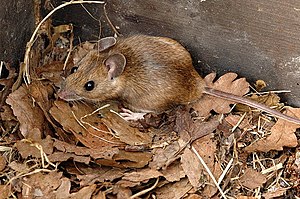Yellow-necked mouse
| Yellow-necked mouse | ||||||||||||
|---|---|---|---|---|---|---|---|---|---|---|---|---|

Yellow-necked mouse ( Apodemus flavicollis ) |
||||||||||||
| Systematics | ||||||||||||
|
||||||||||||
| Scientific name | ||||||||||||
| Apodemus flavicollis | ||||||||||||
| ( Melchior , 1834) |
The yellow-necked mouse ( Apodemus flavicollis ) is a species of mammal from the family of long-tailed mice (Muridae). This medium-sized long-tailed mouse colonizes large parts of the western Palearctic and inhabits forests and other tree-rich habitats. The yellow-necked mouse is one of the most common mammalian species in Europe and, according to the IUCN, is not endangered.
features
The yellow-necked mouse belongs to the medium-sized species of the genus Apodemus . The ears are relatively large, the eyes large and protruding. The head-torso length is 88-130 mm, the tail length 90-135 mm, the length of the hind feet 22-27 mm and the ear length 15-20 mm. The animals weigh 16–56 g, mostly 26–36 g. The fur is warm red or yellow-brown on top. The underside is almost pure white; the demarcation from the upper side coloring is very clear. In Europe, a breast drawing is usually designed as a continuous yellowish-brown collar, only in southern Europe, Asia Minor and the Caucasus is it only present as a longitudinal oval spot. The hind feet are hairy white on top.
distribution and habitat
The distribution area of the yellow-necked mouse covers large parts of the western Palearctic . In a west-east direction, the area extends from Wales , England and the north-west of Spain to the southern Urals , in the south-east via Turkey to the north of Iran . Although the south of Great Britain is populated, the species is absent in the Atlantic west of continental Europe. In north-south direction, the distribution extends from central Sweden and southern Finland to the southern tip of Italy , to the south of Greece and further east to Israel and northern Iran.
Yellow-necked mice are largely tied to forests. Older deciduous forests dominated by beech and oak are considered optimal habitats . In addition, tree-rich hedges and gardens are also inhabited. Yellow-necked mice often invade buildings in autumn. The altitude distribution ranges from sea level to around 2100 m in the Alps , and even higher in the Caucasus .
Way of life
Yellow-necked mice are nocturnal and climb very well, sometimes as far as the crown area of trees. The nests are mostly in earthworks between tree roots or under boulders, less often in piles of wood or in squirrel cobs and nesting boxes up to 8 m high. They mostly take over the earthworks from moles or voles , rarely digging them themselves. The yellow-necked mouse is omnivorous . The diet consists of seeds and fruits such as acorns , beechnuts and hazelnuts , buds as well as insects and other invertebrates ; Occasionally small vertebrates and bird eggs are also eaten. The proportion of animal food is around 10%. For the winter, food depots are created with acorns, hazelnuts or beechnuts. Reproduction takes place in the north of the area from January to October and otherwise largely corresponds to that of the wood mouse .
The yellow-necked mouse shows clear, but not cyclical population fluctuations depending on the food supply. In the forests of Eastern Europe, the settlement density can rise to over 100 individuals / hectare in fattening years .
The yellow-necked mouse as a disease vector
The yellow-necked mouse is identified in the Balkans as a carrier of the Dobrava virus , which belongs to the hantaviruses .
Existence and endangerment
In Great Britain, the populated area has shrunk significantly in historic times due to the conversion of forests into arable land. The yellow-necked mouse is one of the most common mammalian species in Europe; the population is apparently largely stable. According to the IUCN, the species is not endangered worldwide.
swell
literature
- Stéphane Aulagnier, Patrick Haffner, Anthony J. Mitchell-Jones, François Moutou, Jan Zima: The mammals of Europe, North Africa and the Middle East. The destination guide. Haupt, Bern et al. 2009, ISBN 978-3-258-07506-8 , pp. 230-231.
- Anthony J. Mitchell-Jones, Giovanni Amori, Wieslaw Bogdanowicz, Boris Krystufek, PJH Reijnders, Friederike Spitzenberger, Michael Stubbe, Johan BM Thissen, Vladimiŕ Vohralik, Jan Zima: The Atlas of European Mammals. Poyser, London, 1999, ISBN 0-85661-130-1 , pp. 270-271.
- Erwin Stresemann (founder), Konrad Senglaub (ed.): Excursion fauna of Germany. Volume 3: Vertebrates. 12th, heavily edited edition. G. Fischer, Jena et al. 1995, ISBN 3-334-60951-0 , pp. 412-413.
Individual evidence
- ↑ The yellow-necked mouse on the IUCN Red List, with distribution map
- ^ Dietrich Dolch: Contributions to the mammal fauna of the state of Brandenburg - The mammals of the former district of Potsdam (= nature protection and landscape maintenance in Brandenburg. Special issue 1995, ISSN 0942-9328 ). State Environment Agency Brandenburg, Potsdam p. 33.
- ↑ Robert Koch Institute : Profiles of rare and imported infectious diseases ( Memento of the original from August 26, 2016 in the Internet Archive ) Info: The archive link was inserted automatically and has not yet been checked. Please check the original and archive link according to the instructions and then remove this notice. , P. 19
Web links
- Apodemus flavicollis in the endangered Red List species the IUCN 2009. Posted by: Amori, G., Hutterer, R., Krystufek, B., Yigit, N., Mitsain, G. & Palomo, LJ, 2008. Accessed on 20th January 2010.
